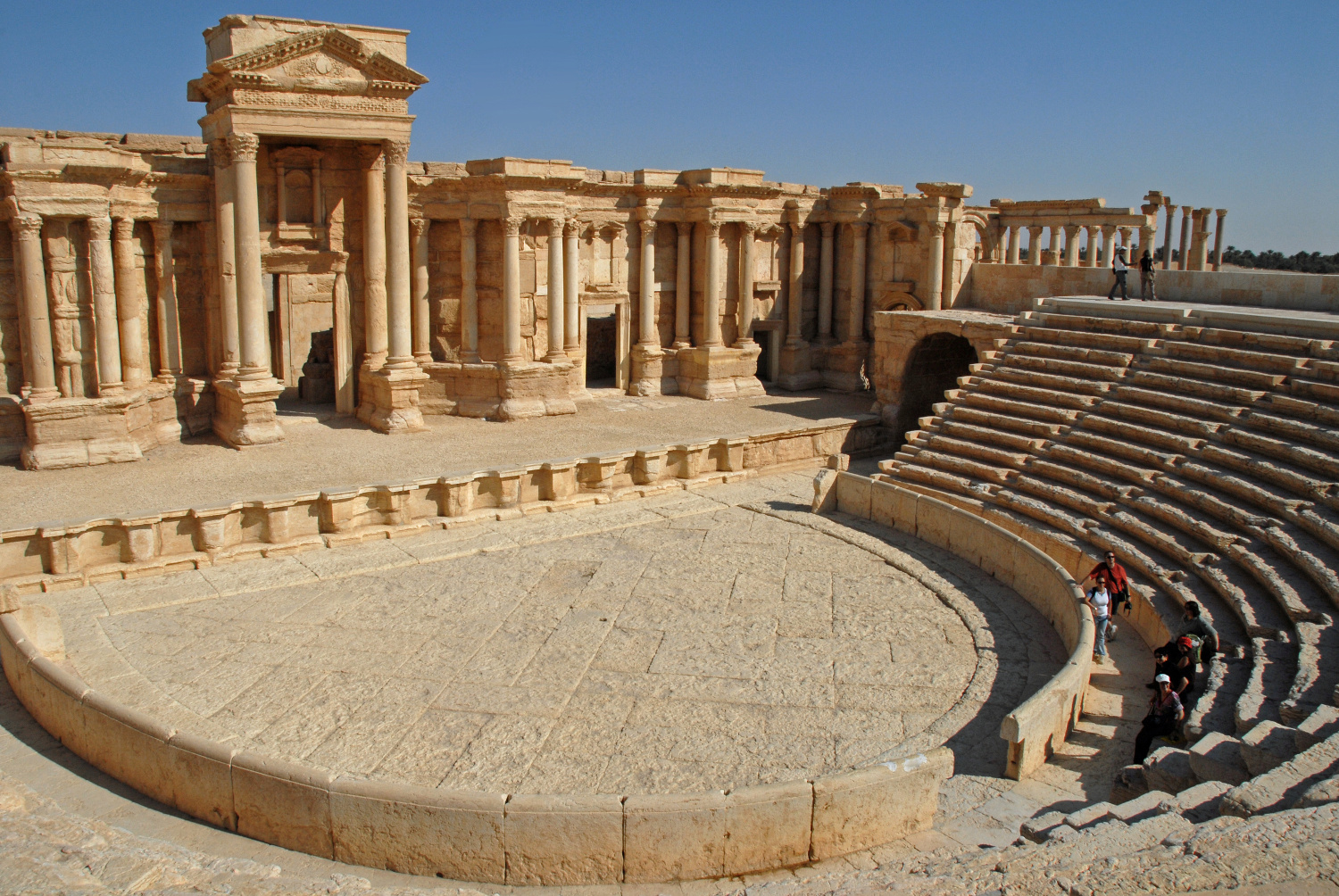

 History
J 0 - 500 AD
History
J 0 - 500 AD

 History
I 500 - 0 BC
History
I 500 - 0 BC

 History
H 1000 - 500 BC
History
H 1000 - 500 BC

 History
G 1500 - 1000 BC
History
G 1500 - 1000 BC

 History
E 2500 - 2000 BC
History
E 2500 - 2000 BC

 History
F 2000 - 1500 BC
History
F 2000 - 1500 BC
 Syria
Syria

 World Heritage
World Heritage

 Civilization
Civilization

Palmyra (arabisch تدمر Tadmur; aramäisch ܬܕܡܘܪܬܐ Tedmurtā; hebräisch תדמור Tadmor), gegenwärtig auch Tadmor genannt, ist eine antike Oasenstadt im heutigen Gouvernement Homs in Syrien. Sie liegt auf dem Gebiet der modernen Stadt Tadmor, die vor dem Bürgerkrieg etwa 51.000 Einwohner hatte.
Die ersten archäologischen Funde stammten aus der Jungsteinzeit. Die erste schriftliche Erwähnung der Stadt selbst erfolgte in altorientalischer Zeit: Sie wurde in den Annalen mehrerer assyrischer Könige und im Alten Testament erwähnt. Palmyra war später Teil des Seleukidenreiches und erlebte seine Blütezeit nach der Annexion durch das Römische Reich im 1. Jahrhundert n. Chr.
Palmyra verfügte über eine gewisse Autonomie innerhalb des Römischen Reiches und wurde Teil der Provinz Syria. Die Metropole besaß einen eigenen Senat, der für öffentliche Arbeiten und die lokale Miliz zuständig war, und ein unabhängiges Steuersystem. Im 3. Jahrhundert wurde sie zur colonia erhoben. In der Zeit der Reichskrise des 3. Jahrhunderts gewann die Stadt stark an politischer Bedeutung und wurde 270 kurzzeitig unabhängig. Das Reich der Stadt stellte einen bedeutenden Machtfaktor im Vorderen Orient dar. Palmyra wurde jedoch 272 von römischen Truppen wieder erobert und die Stadt 273 nach einer gescheiterten zweiten Rebellion weitgehend zerstört.
Palmyra lag an einer wichtigen Karawanenstraße in Syrien, auf halber Strecke von Damaskus über die römische Oase Al-Dumair und weiter über das Kastell Resafa bis zum Euphrat. Inmitten der syrischen Wüste spenden zwei Quellen Wasser, mit dem die noch immer erhaltenen Palmengärten im Süden und Osten der Stadt bewässert werden. Der Reichtum der Stadt ermöglichte die Errichtung von monumentalen Bauprojekten. Im dritten Jahrhundert war die Stadt eine wohlhabende Metropole und zu einem regionalen Zentrum des Nahen Ostens aufgestiegen. Die Palmyrer gehörten zu den renommierten Händlern, etablierten Stationen entlang der Seidenstraße und betrieben im gesamten Reich Handel. Die Sozialstruktur der Stadt war tribal und ihre Bewohner sprachen mit dem Palmyrenischen Dialekt des Aramäischen eine eigene Sprache. Griechisch wurde für kommerzielle und diplomatische Zwecke verwendet. Die Kultur von Palmyra, die durch die Römer, Griechen und Perser beeinflusst wurde, ist in der Region einzigartig. Die Einwohner verehrten lokale Gottheiten und mesopotamische und arabische Götter.
Die Stadt gehört seit der Vertreibung der Osmanen 1918 zu Syrien als eigenständigem Staat. Sie beherbergt heute unverwechselbare Kunst und Architektur und wurde 1980 zum UNESCO-Weltkulturerbe erklärt.Palmyra (/ˌpɑːlˈmaɪrə/; Palmyrene: ![]() Tadmor; Arabic: تَدْمُر Tadmur) is an ancient Semitic city in present-day Homs Governorate, Syria. Archaeological finds date back to the Neolithic period, and documents first mention the city in the early second millennium BC. Palmyra changed hands on a number of occasions between different empires before becoming a subject of the Roman Empire in the first century AD.
Tadmor; Arabic: تَدْمُر Tadmur) is an ancient Semitic city in present-day Homs Governorate, Syria. Archaeological finds date back to the Neolithic period, and documents first mention the city in the early second millennium BC. Palmyra changed hands on a number of occasions between different empires before becoming a subject of the Roman Empire in the first century AD.
The city grew wealthy from trade caravans; the Palmyrenes became renowned as merchants who established colonies along the Silk Road and operated throughout the Roman Empire. Palmyra's wealth enabled the construction of monumental projects, such as the Great Colonnade, the Temple of Bel, and the distinctive tower tombs. Ethnically, the Palmyrenes combined elements of Amorites, Arameans, and Arabs. The city's social structure was tribal, and its inhabitants spoke Palmyrene (a dialect of Aramaic), while using Greek for commercial and diplomatic purposes. Greco-Roman culture influenced the culture of Palmyra, which produced distinctive art and architecture that combined eastern and western traditions. The city's inhabitants worshiped local Semitic deities, Mesopotamian and Arab gods.
By the third century AD Palmyra had become a prosperous regional center. It reached the apex of its power in the 260s, when the Palmyrene King Odaenathus defeated Persian Emperor Shapur I. The king was succeeded by regent Queen Zenobia, who rebelled against Rome and established the Palmyrene Empire. In 273, Roman emperor Aurelian destroyed the city, which was later restored by Diocletian at a reduced size. The Palmyrenes converted to Christianity during the fourth century and to Islam in the centuries following the conquest by the 7th-century Rashidun Caliphate, after which the Palmyrene and Greek languages were replaced by Arabic.
Before AD 273, Palmyra enjoyed autonomy and was attached to the Roman province of Syria, having its political organization influenced by the Greek city-state model during the first two centuries AD. The city became a Roman colonia during the third century, leading to the incorporation of Roman governing institutions, before becoming a monarchy in 260. Following its destruction in 273, Palmyra became a minor center under the Byzantines and later empires. Its destruction by the Timurids in 1400 reduced it to a small village. Under French Mandatory rule in 1932, the inhabitants were moved into the new village of Tadmur, and the ancient site became available for excavations.
Palmyre (Παλμύρα / Palmúra en grec ancien, تدمر / tadmor en arabe) est une oasis du désert de Syrie, à 210 km au nord-est de Damas, où se situe un site historique très riche en ruines archéologiques, et la ville moderne de Tadmor.
Le site est classé patrimoine mondial de l'UNESCO depuis 1980, puis classé « en péril » pendant la guerre civile syrienne.
Palmira (in palmireno ![]() ; in arabo: تدمر), chiamata anche la Sposa del Deserto, fu in tempi antichi una delle più importanti città della Siria.
; in arabo: تدمر), chiamata anche la Sposa del Deserto, fu in tempi antichi una delle più importanti città della Siria.
Palmira (en árabe تدمر Tadmor1 o Tadmir) fue una antigua ciudad situada en el desierto de Siria, en la actual provincia de Homs a 3 km de la moderna ciudad de Tedmor2 o Tadmir, (versión árabe de la misma palabra aramea "palmira", que significa "ciudad de los árboles de dátil"). En la actualidad sólo persisten sus amplias ruinas que son foco de una abundante actividad turística internacional. La antigua Palmira fue la capital del Imperio de Palmira bajo el efímero reinado de la reina Zenobia, entre los años 268 - 272.
Palmira fue elegida como Patrimonio de la Humanidad en 1980. El 20 de junio de 2013, la Unesco incluyó a todos los sitios sirios en la lista del Patrimonio de la Humanidad en peligro para alertar sobre los riesgos a los que están expuestos debido a la Guerra Civil Siria.3










